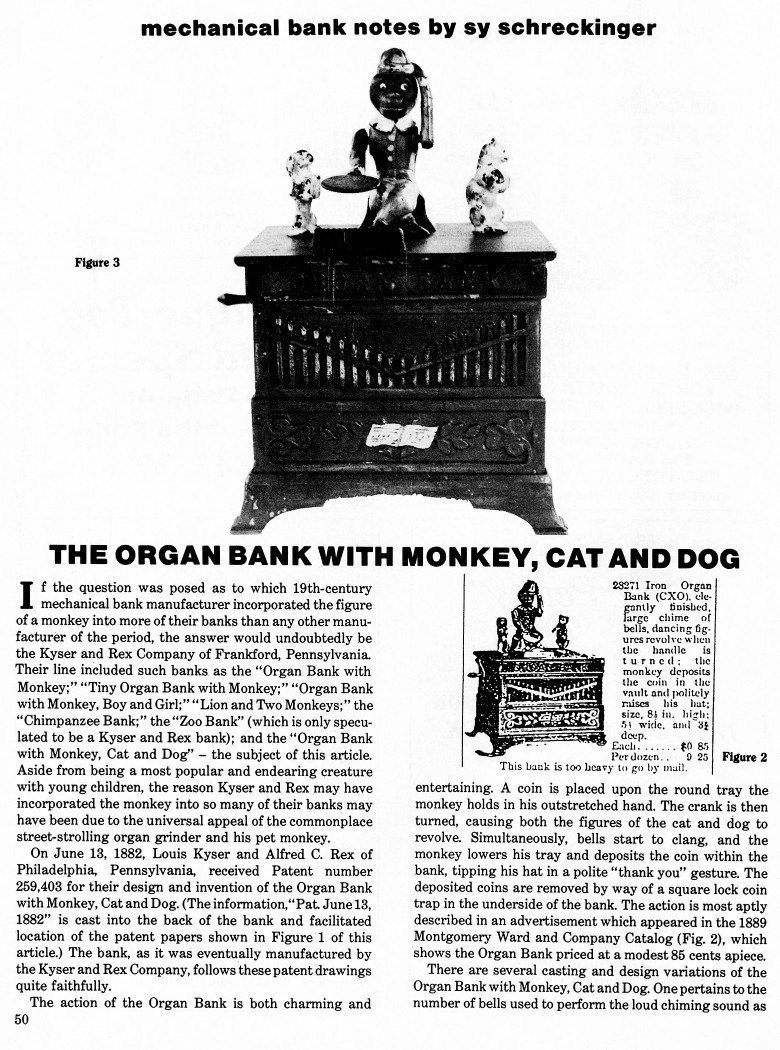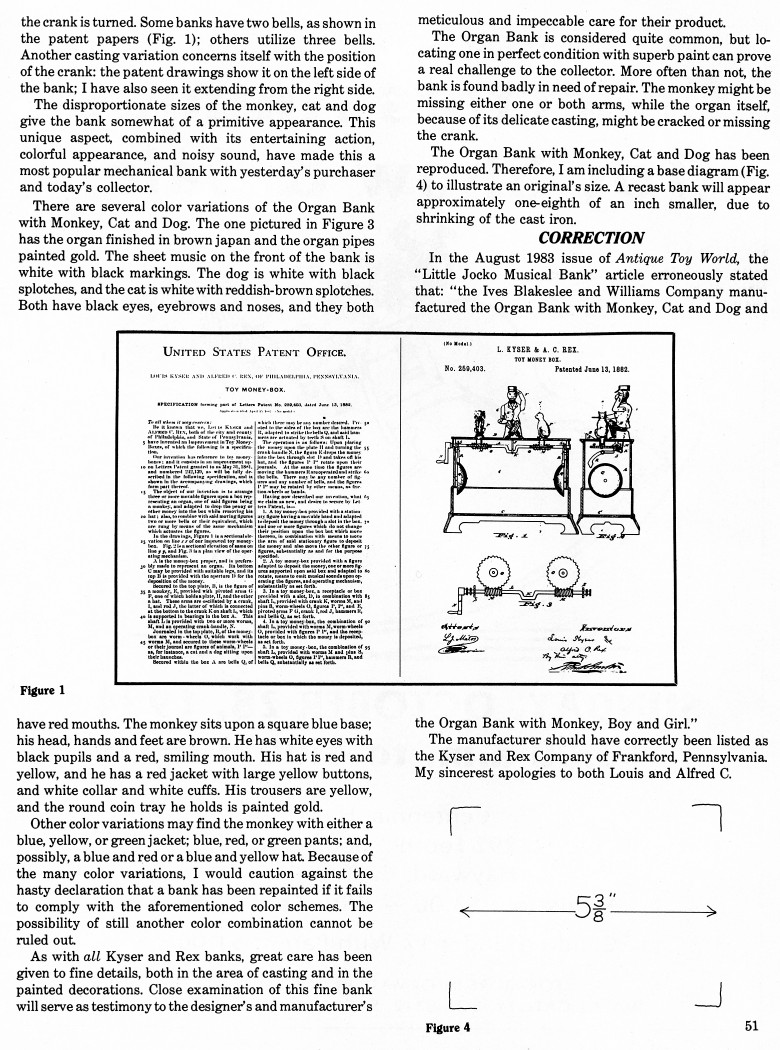|
The Organ Bank with
Monkey,
Cat and Dog
by Sy Schreckinger – ANTIQUE TOY WORLD Magazine – October, 1984
If the
question was posed as to which 19th-century mechanical bank manufacturer
incorporated the figure of a monkey into more of their banks than any
other manufacturer of the period, the answer would undoubtedly be the
Kyser and Rex Company of Frankford, Pennsylvania. Their line included such
banks as the "Organ Bank with Monkey;" "Tiny Organ Bank with Monkey;"
"Organ Bank with Monkey, Boy and Girl;" "Lion and Two Monkeys;" the
"Chimpanzee Bank;" the "Zoo Bank" (which is only speculated to be a Kyser
and Rex bank); and the "Organ Bank with Monkey, Cat and Dog" – the subject
of this article. Aside from being a most popular and endearing creature
with young children, the reason Kyser and Rex may have incorporated the
monkey into so many of their banks may have been due to the universal
appeal of the commonplace street-strolling organ grinder and his pet
monkey.
On June 13, 1882, Louis Kyser and Alfred C. Rex of Philadelphia,
Pennsylvania, received Patent number
259,403 for their design and
invention of the Organ Bank with Monkey, Cat and Dog. (The information,"
Pat. June 13, 1882" is cast into the back of the bank and facilitated
location of the patent papers shown in Figure 1 of this article.) The
bank, as it was eventually manufactured by the Kyser and Rex Company,
follows these patent drawings quite faithfully.
The action of the Organ Bank is both charming and entertaining. A
coin is placed upon the round tray the monkey holds in his outstretched
hand. The crank is then turned, causing both the figures of the cat and
dog to revolve. Simultaneously, bells start to clang, and the monkey
lowers his tray and deposits the coin within the bank, tipping his hat in
a polite "thank you" gesture. The deposited coins are removed by way of a
square lock coin trap in the underside of the bank. The action is most
aptly described in an advertisement which appeared in the 1889 Montgomery
Ward and Company Catalog (Fig. 2), which shows the Organ Bank priced at a
modest 85 cents apiece.
There are several casting and design variations of the Organ Bank
with Monkey, Cat and Dog. One pertains to the number of bells used to
perform the loud chiming sound as the crank is turned. Some banks have two
bells, as shown in the patent papers (Fig. 1); others utilize three bells.
Another casting variation concerns itself with the position of the crank:
the patent drawings show it on the left side of the bank; I have also seen
it extending from the right side.
The disproportionate sizes of the monkey, cat and dog give the bank
somewhat of a primitive appearance. This unique aspect, combined with its
entertaining action, colorful appearance, and noisy sound, have made this
a most popular mechanical bank with yesterday's purchaser and today's
collector.
There are several color variations of the Organ Bank with Monkey, Cat
and Dog. The one pictured in Figure 3 has the organ finished in brown
japan and the organ pipes painted gold. The sheet music on the front of
the bank is white with black markings. The dog is white with black
splotches, and the cat is white with reddish-brown splotches. Both have
black eyes, eyebrows and noses, and they both have red mouths. The monkey
sits upon a square blue base; his head, hands and feet are brown. He has
white eyes with black pupils and a red, smiling mouth. His hat is red and
yellow, and he has a red jacket with large yellow buttons, and white
collar and white cuffs. His trousers are yellow, and the round coin tray
he holds is painted gold.
Other color variations may find the monkey with either a blue,
yellow, or green jacket; blue, red, or green pants; and, possibly, a blue
and red or a blue and yellow hat. Because of the many color variations, I
would caution against the hasty declaration that a bank has been repainted
if it fails to comply with the aforementioned color schemes. The
possibility of still another color combination cannot be ruled out.
As with all Kyser and Rex banks, great care has been given to fine
details, both in the area of casting and in the painted decorations. Close
examination of this fine bank will serve as testimony to the designer's
and manufacturer's meticulous and impeccable care for their product.
The Organ Bank is considered quite common, but locating one in
perfect condition with superb paint can prove a real challenge to the
collector. More often than not, the bank is found badly in need of repair.
The monkey might be missing either one or both arms, while the organ
itself, because of its delicate casting, might be cracked or missing the
crank.
The Organ Bank with Monkey, Cat and Dog has been reproduced.
Therefore, I am including a base diagram (Fig. 4) to illustrate an
original's size. A recast bank will appear approximately one-eighth of an
inch smaller, due to shrinking of the cast iron.
CORRECTION: In the
August 1983 issue of Antique Toy World, the "Little Jocko
Musical Bank" article erroneously stated that: "the Ives Blakeslee and
Williams Company manufactured the Organ Bank with Monkey, Cat and Dog and
the Organ Bank with Monkey, Boy and Girl."
The manufacturer should have correctly been listed as the Kyser and
Rex Company of Frankford, Pennsylvania. My sincerest apologies to both
Louis and Alfred C.
|


